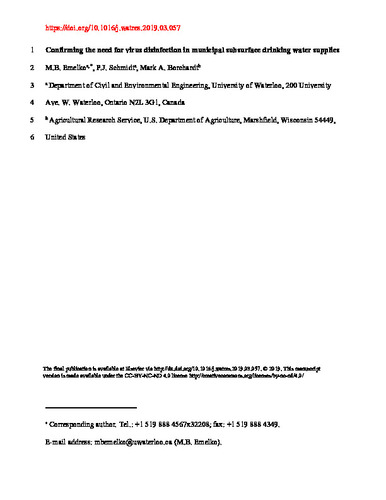| dc.contributor.author | Emelko, Monica B. | |
| dc.contributor.author | Schmidt, Philip J. | |
| dc.contributor.author | Borchardt, Mark A. | |
| dc.date.accessioned | 2022-03-10 18:42:54 (GMT) | |
| dc.date.available | 2022-03-10 18:42:54 (GMT) | |
| dc.date.issued | 2019-06 | |
| dc.identifier.uri | https://doi.org/10.1016/j.watres.2019.03.057 | |
| dc.identifier.uri | http://hdl.handle.net/10012/18105 | |
| dc.description | The final publication is available at Elsevier via http://dx.doi.org/10.1016/j.watres.2019.03.057. © 2019. This manuscript version is made available under the CC-BY-NC-ND 4.0 license http://creativecommons.org/licenses/by-nc-nd/4.0/ | en |
| dc.description.abstract | Enteric viruses pose the greatest acute human health risks associated with subsurface drinking water supplies, yet quantitative risk assessment tools have rarely been used to develop health-based targets for virus treatment in drinking water sourced from these supplies. Such efforts have previously been hampered by a lack of consensus concerning a suitable viral reference pathogen and dose-response model and difficulties in quantifying pathogenic viruses in water. A reverse quantitative microbial risk assessment (QMRA) framework and quantitative polymerase chain reaction data for norovirus genogroup I in subsurface water supplies were used herein to evaluate treatment needs for subsurface drinking water supplies. Norovirus was not detected in over 90% of samples, which emphasizes the need to consider the spatially and/or temporally intermittent patterns of enteric pathogen contamination in subsurface water supplies. Collectively, this analysis reinforces existing recommendations that a minimum 4-log treatment goal is needed for enteric viruses in groundwater in absence of well-specific monitoring information. This result is sensitive to the virus dose-response model used as there is approximately a 3-log discrepancy among virus dose-response models in the existing literature. This emphasizes the need to address the uncertainties and lack of consensus related to various QMRA modelling approaches and the analytical limitations that preclude more accurate description of virus risks. | en |
| dc.description.sponsorship | Natural Sciences and Engineering Research Council of Canada (NSERC), RGPIN-2016-04655 || U.S. EPA STAR, Grant R831630. | en |
| dc.language.iso | en | en |
| dc.publisher | Elsevier | en |
| dc.relation.ispartofseries | Water research; | |
| dc.rights | Attribution-NonCommercial-NoDerivatives 4.0 International | * |
| dc.rights.uri | http://creativecommons.org/licenses/by-nc-nd/4.0/ | * |
| dc.subject | groundwater | en |
| dc.subject | quantitative microbial risk assessment | en |
| dc.subject | norovirus | en |
| dc.title | Confirming the need for virus disinfection in municipal subsurface drinking water supplies | en |
| dc.type | Article | en |
| dcterms.bibliographicCitation | Emelko, M. B., Schmidt, P. J., & Borchardt, M. A. (2019). Confirming the need for virus disinfection in municipal subsurface drinking water supplies. Water Research, 157, 356–364. https://doi.org/10.1016/j.watres.2019.03.057 | en |
| uws.contributor.affiliation1 | Faculty of Engineering | en |
| uws.contributor.affiliation2 | Civil and Environmental Engineering | en |
| uws.typeOfResource | Text | en |
| uws.peerReviewStatus | Reviewed | en |
| uws.scholarLevel | Faculty | en |


